Device For Performing A Sitting Plank Exercise
Carney; John P.
U.S. patent application number 16/518286 was filed with the patent office on 2019-11-21 for device for performing a sitting plank exercise. The applicant listed for this patent is John P. Carney. Invention is credited to John P. Carney.
| Application Number | 20190351279 16/518286 |
| Document ID | / |
| Family ID | 68534066 |
| Filed Date | 2019-11-21 |
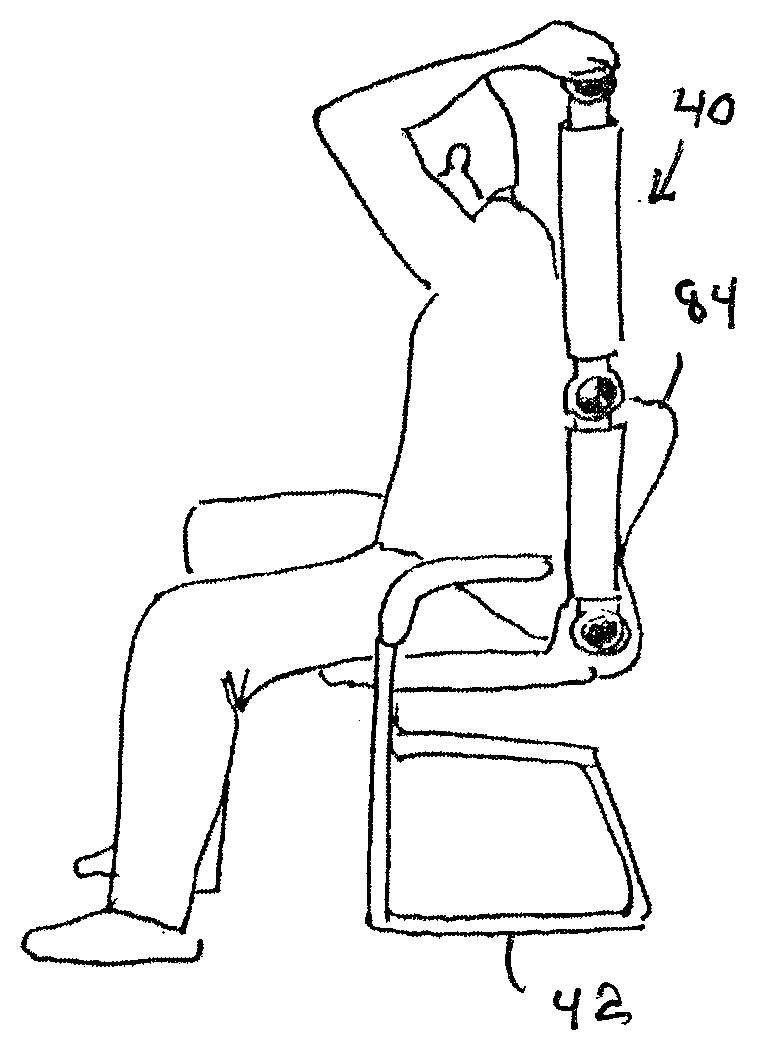
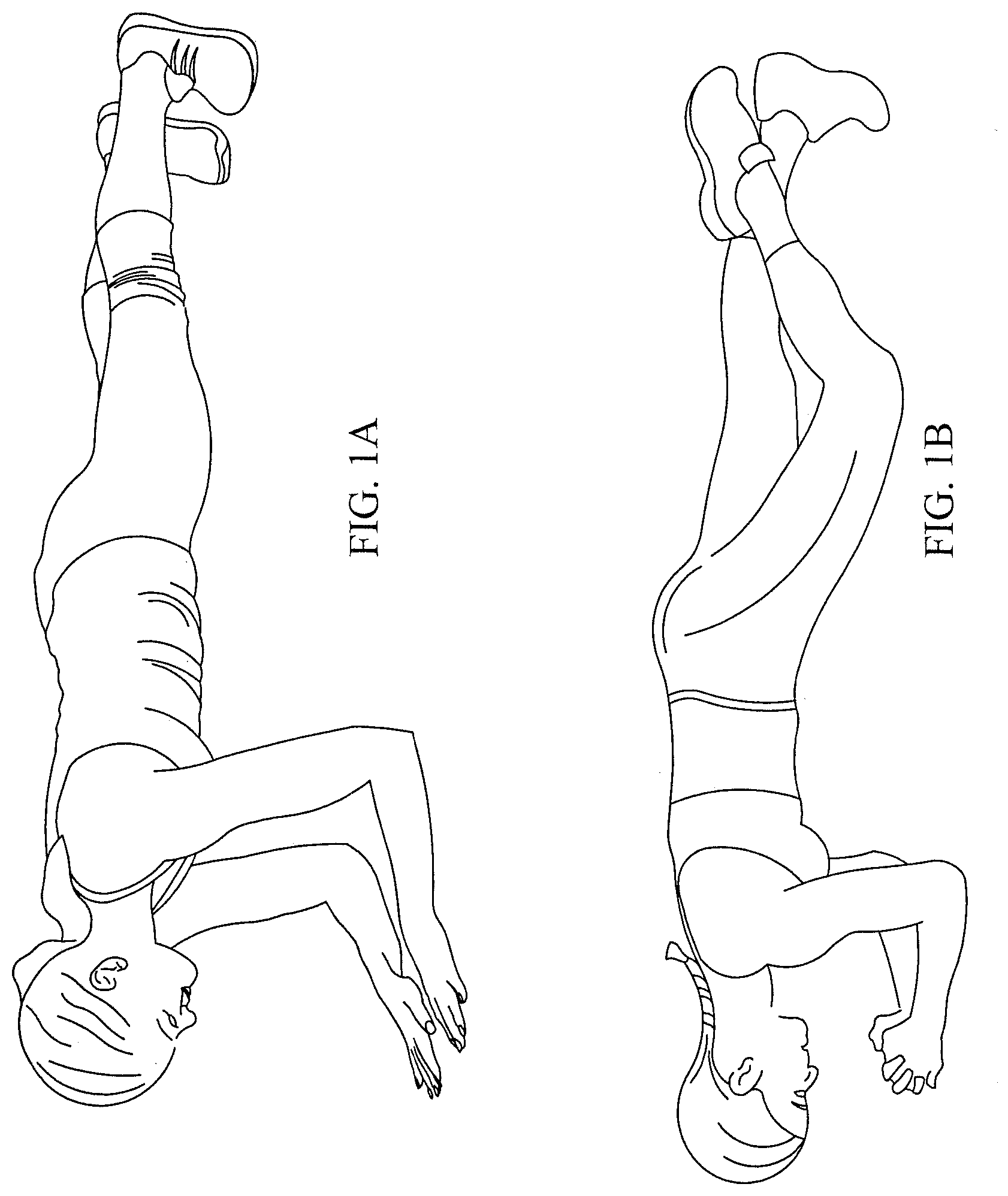
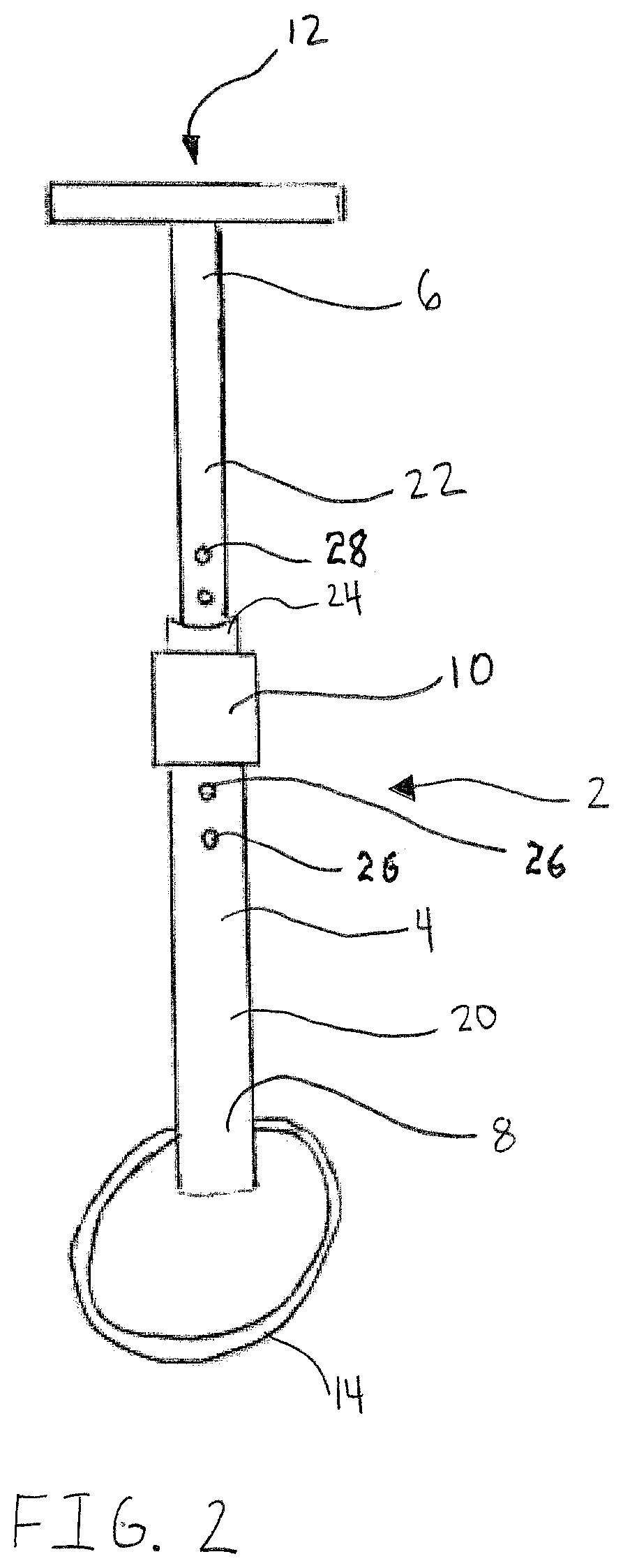

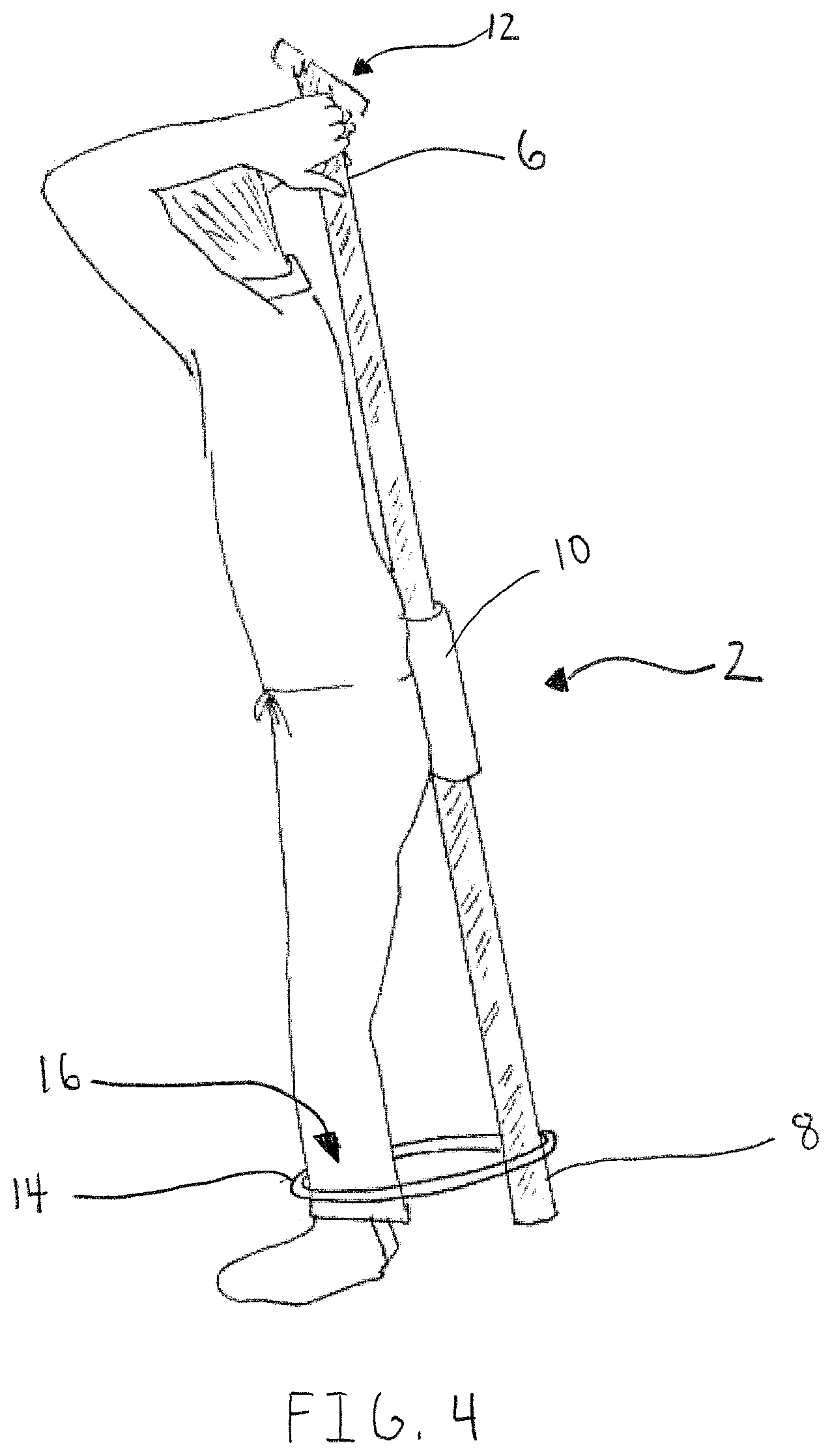
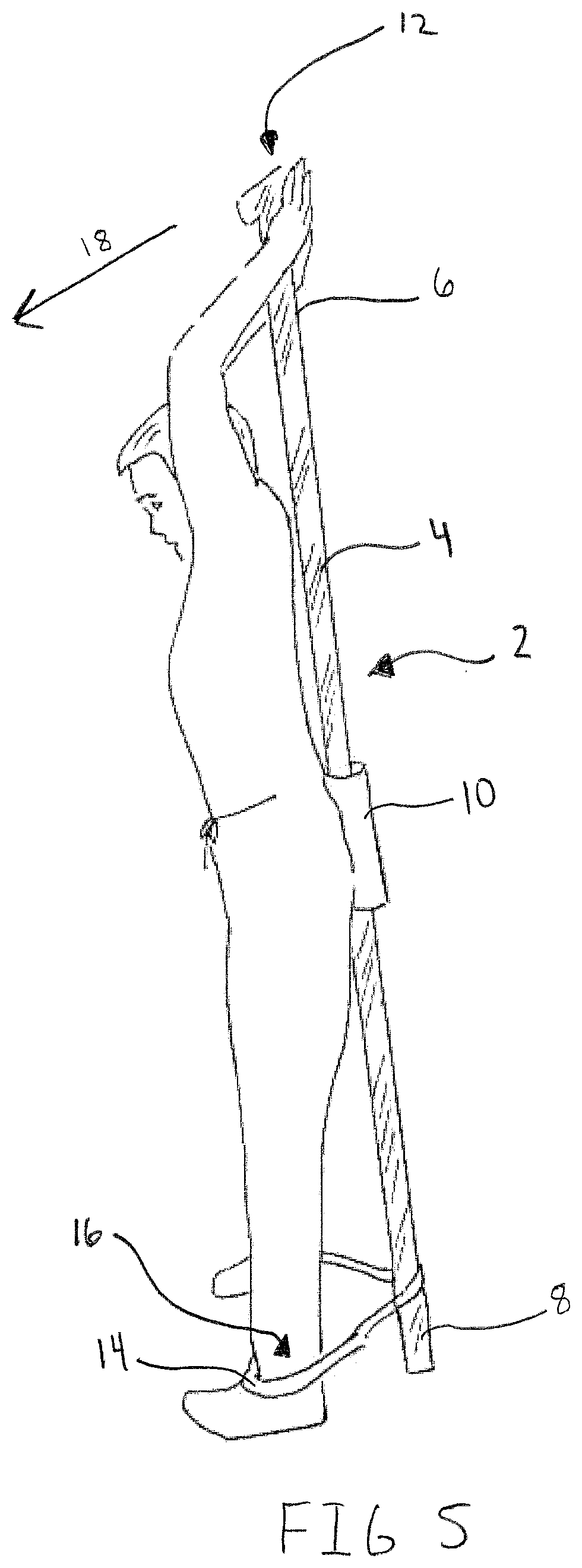
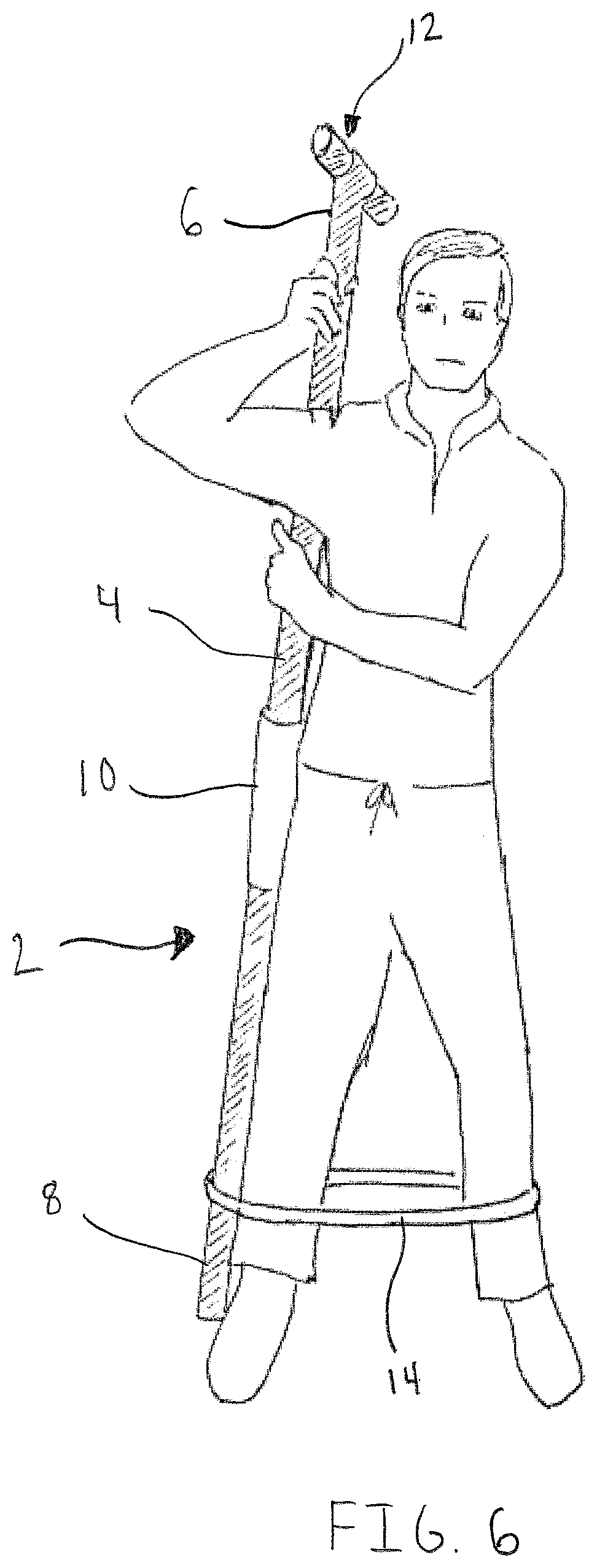

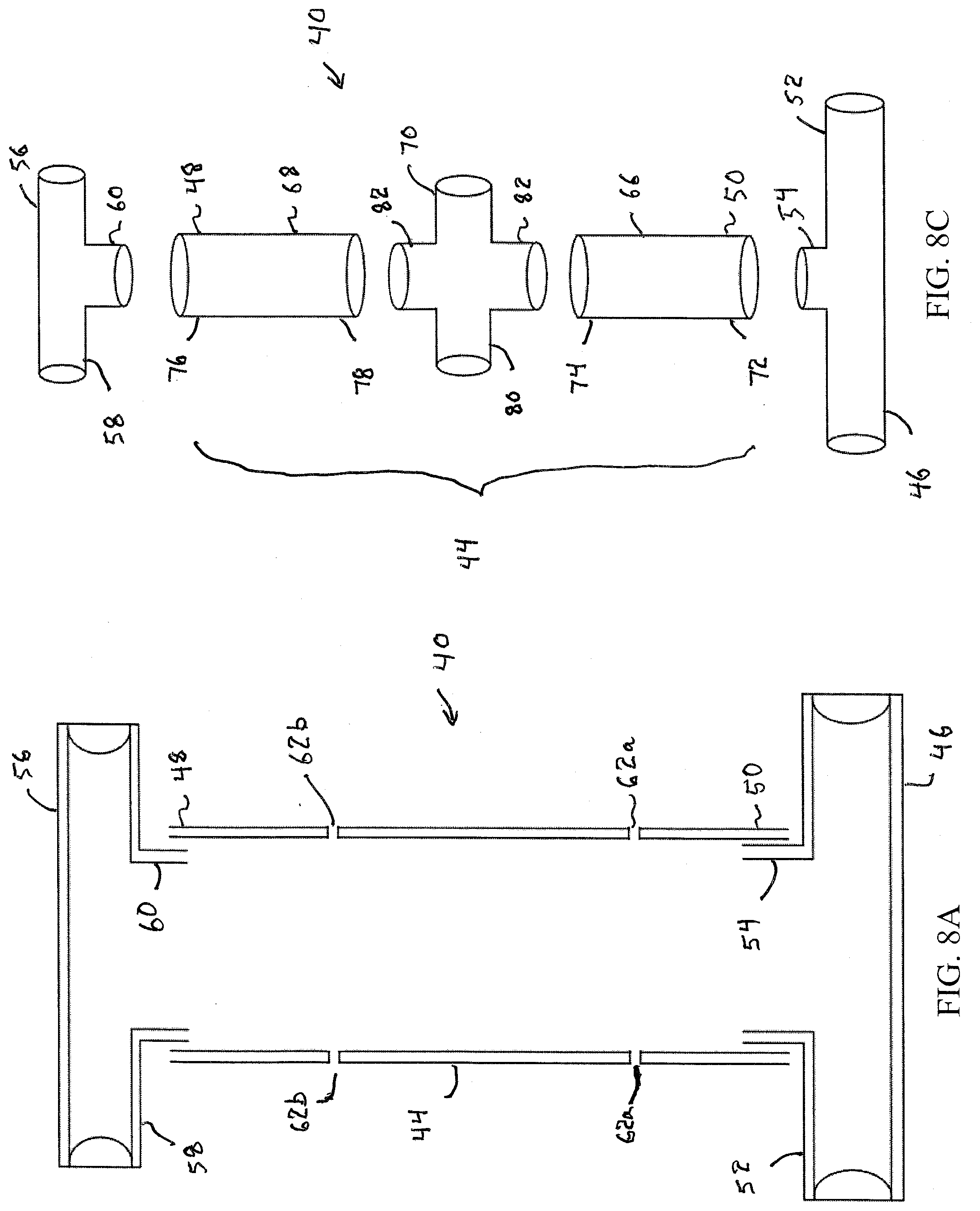
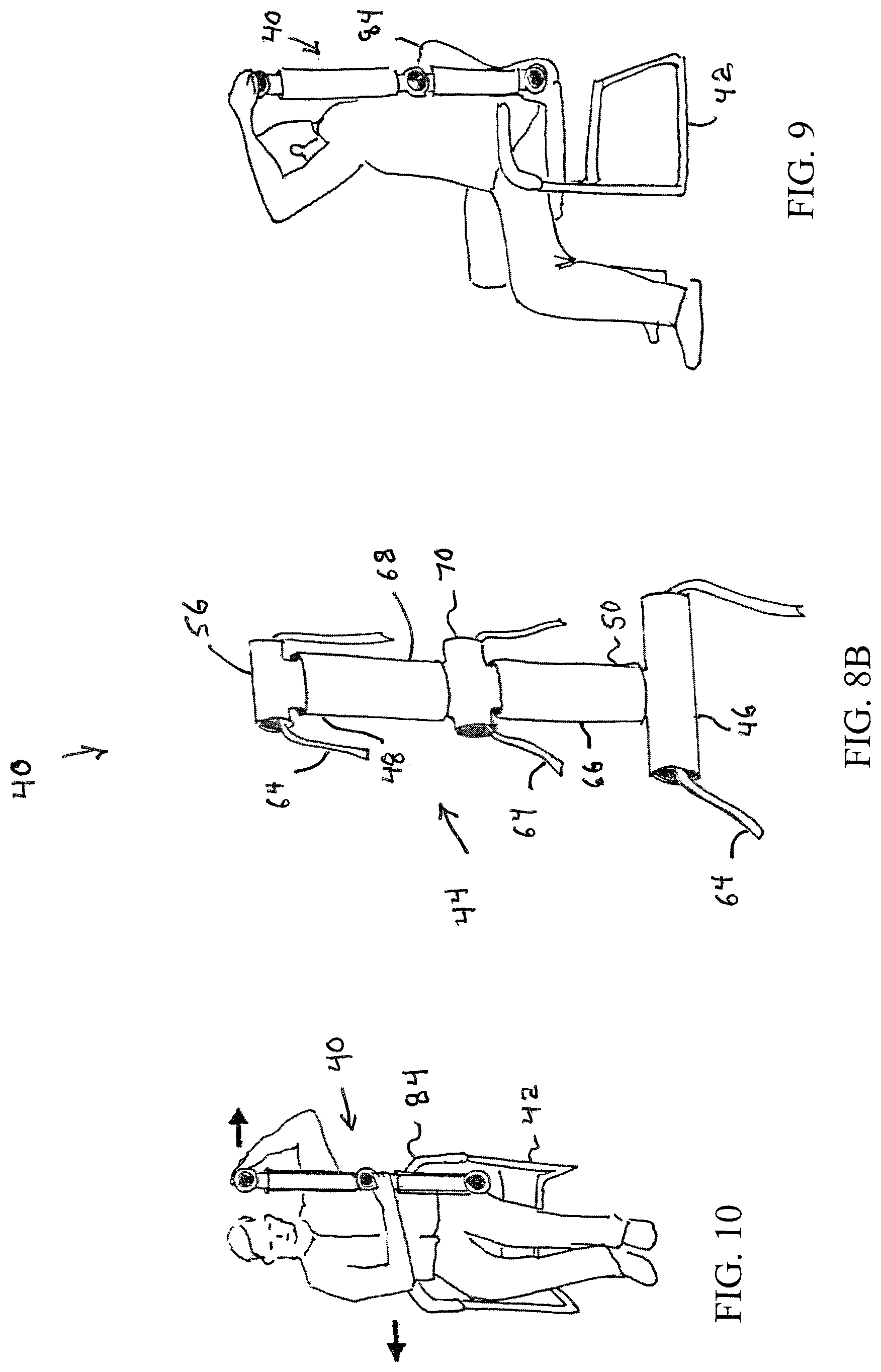
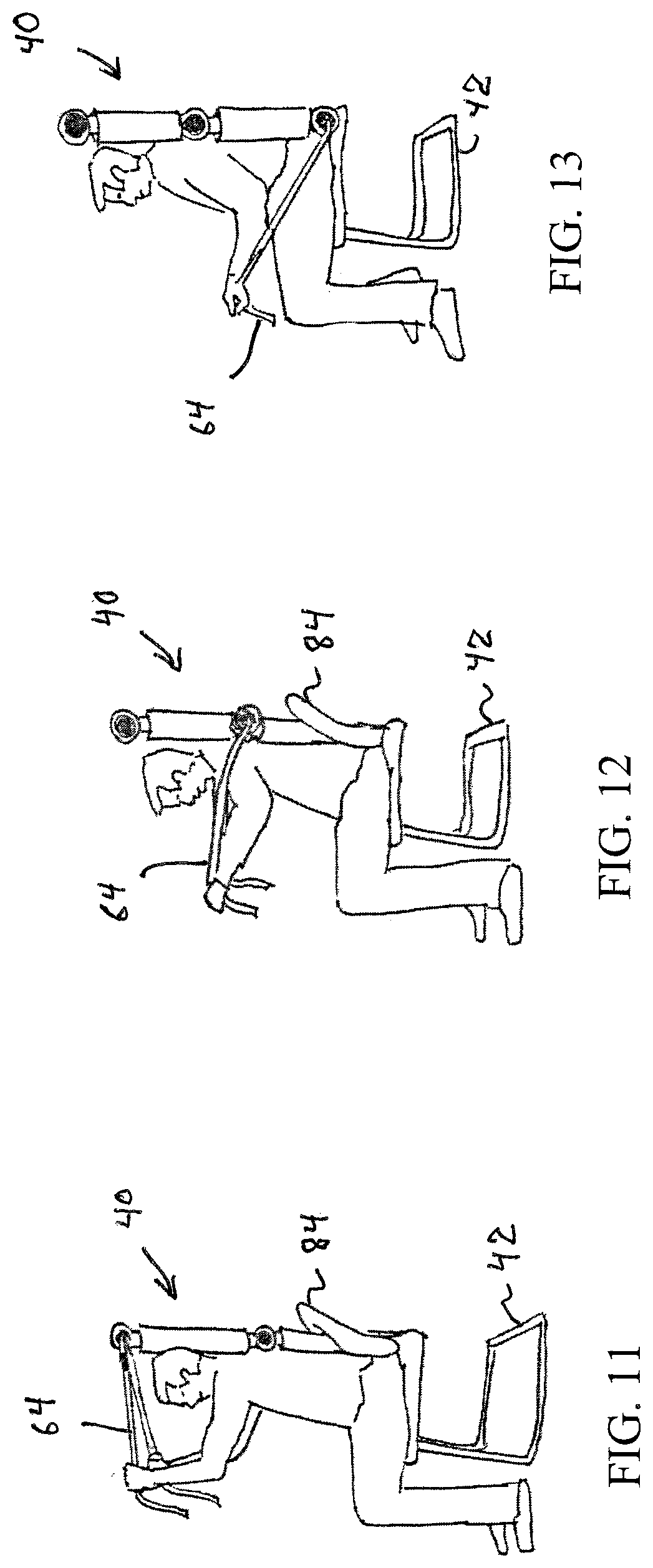
| United States Patent Application | 20190351279 |
| Kind Code | A1 |
| Carney; John P. | November 21, 2019 |
DEVICE FOR PERFORMING A SITTING PLANK EXERCISE
Abstract
A device for performing a standing plank exercise includes an elongated main body having a first axial end and an oppositely disposed second axial end. The main body has at least two telescoping members that may be adjusted to vary the length of the main body and the corresponding degree of stress provided by the exercise or to adjust for the user's height. The device includes a support pad positioned at a fulcrum or pivot point on the elongated main body between the first axial end and the second axial end. A handle portion is mounted to or extends from the main body and is graspable by a user. An ankle strap is coupled to the elongated main body in proximity to the second axial end thereof and may encircle the ankles of a user. The device is oriented substantially vertically during an exercise regimen. A device for performing a sitting plank exercise includes a primary tubular member, a supporting base member affixed to one axial end of the primary tubular member, and a grasping piece affixed to the other axial end of the primary tubular member.
| Inventors: | Carney; John P.; (Paramus, NJ) | ||||||||||
| Applicant: |
|
||||||||||
|---|---|---|---|---|---|---|---|---|---|---|---|
| Family ID: | 68534066 | ||||||||||
| Appl. No.: | 16/518286 | ||||||||||
| Filed: | July 22, 2019 |
Related U.S. Patent Documents
| Application Number | Filing Date | Patent Number | ||
|---|---|---|---|---|
| 15982535 | May 17, 2018 | |||
| 16518286 | ||||
| Current U.S. Class: | 1/1 |
| Current CPC Class: | A63B 2208/0219 20130101; A63B 2210/58 20130101; A63B 2208/0204 20130101; A63B 2208/0233 20130101; A63B 21/0552 20130101; A63B 23/03541 20130101; A63B 21/0442 20130101; A63B 21/4035 20151001; A63B 21/0023 20130101; A63B 2225/093 20130101; A63B 2209/00 20130101; A63B 21/00061 20130101; A63B 2071/0694 20130101; A63B 21/4033 20151001; A63B 23/12 20130101 |
| International Class: | A63B 21/00 20060101 A63B021/00; A63B 21/002 20060101 A63B021/002; A63B 21/055 20060101 A63B021/055; A63B 21/04 20060101 A63B021/04; A63B 23/035 20060101 A63B023/035; A63B 23/12 20060101 A63B023/12 |
Claims
1. (canceled)
2. (canceled)
3. (canceled)
4. (canceled)
5. (canceled)
6. (canceled)
7. (canceled)
8. (canceled)
9. (canceled)
10. A device for performing a sitting plank exercise, which comprises: an elongated, primary tubular member, the primary tubular member having a first axial end and a second axial end situated axially opposite the first axial end; and a supporting base member, the supporting base member being affixed to the second axial end of the primary tubular member.
11. A device for performing a sitting plank exercise as defined by claim 10, wherein the primary tubular member has a longitudinal axis associated therewith; wherein the supporting base member has a longitudinal axis associated therewith; and wherein the supporting base member is affixed to the primary tubular member such that the longitudinal axis thereof is disposed perpendicularly to the longitudinal axis of the primary tubular member.
12. A device for performing a sitting plank exercise as defined by claim 10, which further comprises: a grasping piece, the grasping piece being affixed to the first axial end of the primary tubular member.
13. A device for performing a sitting plank exercise as defined by claim 12, wherein the primary tubular member has a longitudinal axis associated therewith; wherein the grasping piece has a longitudinal axis associated therewith; and wherein the grasping piece is affixed to the primary tubular member such that the longitudinal axis thereof is disposed perpendicularly to the longitudinal axis of the primary tubular member.
14. A device for performing a sitting plank exercise as defined by claim 10, wherein the primary tubular member includes at least one pair of diametrically opposed openings formed therein; and wherein the device further comprises: an elastic band, the elastic band passing through the at least one pair of diametrically disposed openings formed in the primary tubular member, the elastic band being graspable by a user of the device when performing an exercise.
15. A device for performing a sitting plank exercise as defined by claim 10, which further comprises: a grasping piece, the grasping piece being affixed to the first axial end of the primary tubular member; wherein the primary tubular member has a longitudinal axis associated therewith; wherein the supporting base member has a longitudinal axis associated therewith; wherein the grasping piece has a longitudinal axis associated therewith; wherein the supporting base member is affixed to the primary tubular member such that the longitudinal axis thereof is disposed perpendicularly to the longitudinal axis of the primary tubular member; wherein the grasping piece is affixed to the primary tubular member such that the longitudinal axis thereof is disposed perpendicularly to the longitudinal axis of the primary tubular member; wherein the supporting base member is formed as a generally tubular, hollow, T-shaped member having a first tubular component and a second tubular component situated midway on the axial length of the first tubular component thereof and extending perpendicularly therefrom, the second tubular component of the supporting base member being mounted to the second axial end of the primary tubular member; and wherein the grasping piece is formed as a generally tubular, hollow, T-shaped member having a first tubular component and a second tubular component situated midway on the axial length of the first tubular component thereof and extending perpendicularly therefrom, the second tubular component of the grasping piece being mounted to the first axial end of the primary tubular member.
16. A device for performing a sitting plank exercise as defined by claim 15, wherein the first tubular component of the supporting base member has a bore formed therein and opposite open axial ends in communication with the bore formed therein; wherein the first tubular component of the grasping piece has a bore formed therein and opposite open axial ends in communication with the bore formed therein; and wherein the device further comprises: at least one elastic band, the at least one elastic band being receivable by and passable through at least one of the bore and the open axial ends of the first tubular component of the supporting base member and the bore and the open axial ends of the first tubular component of the grasping piece, the at least one elastic band being graspable by a user of the device when performing an exercise.
17. A device for performing a sitting plank exercise as defined by claim 16, wherein the at least one elastic band includes at least a first elastic band and a second elastic band, at least one of the first elastic band and the second elastic band being receivable by and passable through at least one of the bore and open axial ends of the first tubular component of the supporting base member and the bore and open axial ends of the first tubular component of the grasping piece; wherein the first elastic band has associated therewith a first elasticity to provide a first resistance to a user of the device when performing an exercise; wherein the second elastic band has a second elasticity to provide a second resistance to a user of the device when performing an exercise; and wherein the first elasticity and first resistance of the first elastic band are different respectively from the second elasticity and second resistance of the second elastic band.
18. A device for performing a sitting plank exercise as defined by claim 17, wherein the first elastic band includes a first color; wherein the second elastic band includes a second color; and wherein the first color of the first elastic band is different from the second color of the second elastic band.
19. A device for performing a sitting plank exercise as defined by claim 18, wherein the primary tubular member includes a first tubular section, a second tubular section and an intermediate tubular section, the first tubular section of the primary tubular member having a first axial end and an opposite second axial end, the second tubular section of the primary tubular member having a first axial end and an opposite second axial end, the second tubular component of the supporting base member being mounted to the first axial end of the first tubular section of the primary tubular member, the second tubular component of the grasping piece being mounted to the first axial end of the second tubular section of the primary tubular member, the second axial end of the first tubular section of the primary tubular member being mounted to the intermediate tubular section, the second axial end of the second tubular section of the primary tubular member being mounted to the intermediate tubular section.
20. A device for performing a sitting plank exercise as defined by claim 19, wherein the intermediate tubular section includes a first tubular component having associated therewith a longitudinal axis, and a pair of opposite second tubular components which extend in opposite directions perpendicularly to the longitudinal axis of the first tubular component of the intermediate tubular section, one of the second tubular components of the pair of opposite second tubular components of the intermediate tubular section being mounted to the second axial end of the first tubular section of the primary tubular member, the other second tubular component of the pair of opposite second tubular components of the intermediate tubular section being mounted to the second axial end of the second tubular section of the primary tubular member; wherein the first tubular component of the intermediate tubular section includes a bore formed therein and opposite open axial ends in communication with the bore; and wherein at least one of the at least first elastic band and the second elastic band is receivable by and passable through the bore and opposite open axial ends of the first tubular component of the intermediate tubular section so as to be graspable by a user of the device when performing an exercise.
Description
CROSS-REFERENCE TO RELATED APPLICATIONS
[0001] This application is a continuation-in-part of U.S. application Ser. No. 15/982,535, filed on May 17, 2018, and entitled "Device For Performing A Standing Plank Exercise", the disclosure of which is incorporated herein by reference and on which priority is hereby claimed.
BACKGROUND OF THE INVENTION
Field of the Invention
[0002] The present invention generally relates to exercise equipment, and more particularly relates to devices for assisting with manual body stress exercises.
Description of the Prior Art
[0003] The plank exercise is a popular exercise that stresses the core muscles of the body such as the abdomen, lower back and upper legs. The plank exercise is utilized in a variety of exercise routines and is common in yoga studios and fitness classes. In fact, plank exercises are also often utilized by professional athletes.
[0004] The plank exercise is relatively simple. As can be seen in FIGS. 1A and 1B of the drawings, the exercise is performed by maintaining the body in a straight position, like a "plank" of wood, while the body is supported by the forearms and feet. In the traditional plank exercise illustrated by FIG. 1A, both feet of the person rest on the floor or ground, while in the modified plank exercise illustrated by FIG. 1B, one foot engages the floor or ground and the ankle of the persons other leg rests atop the supporting leg. When performing a plank exercise, fitness enthusiasts attempt to maintain the plank position for as long as possible until failure. By maintaining the challenging plank position, the core muscles are stressed and subsequently strengthened.
[0005] A traditional plank exercise is performed while lying on the floor. The degree and location of stress and strengthening that can be obtained from a traditional plank exercise is limited by the distance between the forearms and feet of the user, as well as the relative angle created between the user and the ground. Accordingly, since the distance between a user's forearms and feet is generally unchangeable, the degree and location of stress and strengthening accomplished by plank exercises is restricted. Furthermore, the conventional plank exercise places as much stress on the shoulders and arms as on the core muscles, and thus does not effectively target the core muscles.
[0006] The present invention provides a novel apparatus that enables a user to perform a plank exercise while standing or sitting.
OBJECTS AND SUMMARY OF THE INVENTION
[0007] It is an object of the present invention to provide a device for performing a standing plank exercise.
[0008] It is another object of the present invention to provide a device for performing a standing plank exercise that focuses the exercise on the user's core muscles.
[0009] It is yet another object of the present invention to provide a device for performing a standing plank exercise which is selectively adjustable in length to vary the degree of stress placed on the user during the exercise.
[0010] It is a further object of the present invention to provide a device for performing a sitting plank exercise.
[0011] It is still a further object of the present invention to provide a device for performing a sitting plank exercise that focuses the exercise on the user's core muscles.
[0012] It is yet a further object of the present invention to provide a device for performing a sitting plank exercise which includes structure for the user to vary the degree of stress placed on the user during the exercise.
[0013] In one form of the present invention, a device for performing a standing plank exercise includes an elongated main body having a first lateral side, a second lateral side, a first axial end and a second axial end. A support pad that supports a user's back is positioned on the elongated main body between the first axial end and second axial end thereof.
[0014] The device preferably further includes an ankle strap coupled to the elongated main body in proximity to the second axial end thereof which selectively joins the elongated main body to a portion of the body of the user.
[0015] The elongated main body is preferably formed as at least two telescoping members that may be selectively extended and retracted within one another to vary the length of the elongated main body and the corresponding degree of stress placed on the user during the exercise.
[0016] In another form of the present invention, the device for performing a standing plank exercise may include a handle portion positioned perpendicularly to the elongated main body in proximity to the first axial end thereof, the handle portion being graspable by the user during the exercise.
[0017] In yet another embodiment, the exercise device of the present invention can apply a plank or other type of exercise to a person while the person is sitting. In one form of this sitting plank exerciser, a primary tubular member in the form of a single elongated tube or a plurality of interconnected tubes extends from a perpendicularly disposed supporting base tubular member. Resilient or stretchable bands, the ends of which are grasped by the user, may extend from diametrically opposite sides of the primary tubular member at different locations along the axial length thereof, and from the supporting base member. The band or bands may have different resistances in their elasticity, and such resistances may be denoted by different colors of the bands. In this way, a person using the sitting plank exerciser of the present invention may easily select a band of a particular resistance or elasticity, and may position the band at a desired location along the axial length of the primary tubular member to work different muscles in the user's body.
[0018] These and other objects, features and advantages of the present invention will be apparent from the following detailed description of illustrative embodiments thereof, which is to be read in connection with the accompanying drawings.
BRIEF DESCRIPTION OF THE DRAWINGS
[0019] FIG. 1A is a left perspective view of a user performing a traditional plank exercise.
[0020] FIG. 1B is another left perspective view of a user performing a traditional plank exercise.
[0021] FIG. 2 is a front perspective view of a device for performing a standing plank exercise formed in accordance with the present invention.
[0022] FIG. 3 is a top left perspective view of the device for performing a standing plank exercise formed in accordance with the present invention.
[0023] FIG. 4 is a left perspective view of the device for performing a standing plank exercise formed in accordance with the present invention, showing the device positioned on the user.
[0024] FIG. 5 is another left perspective view of the device for performing a standing plank exercise formed in accordance with the present invention, showing the device positioned on the user.
[0025] FIG. 6 is a perspective view of the device for performing a standing plank exercise formed in accordance with the present invention, showing the device positioned on the side of the user.
[0026] FIG. 7 is a perspective view of the device for performing a standing plank exercise formed in accordance with the present invention, showing the device positioned on the front side of the user.
[0027] FIG. 8A is a longitudinal cross-sectional view of a first form of a device for performing a sitting plank exercise formed in accordance with the present invention.
[0028] FIG. 8B is a perspective view of a second form of a device for performing a sitting plank exercise formed in accordance with the present invention.
[0029] FIG. 8C is an exploded perspective view of the device of the present invention shown in FIG. 8B.
[0030] FIG. 9 is a perspective view of the device for performing a sitting plank exercise formed in accordance with the present invention and shown in FIG. 8 of the drawings, and illustrating the device being used in a first mode by a person sitting in a chair to exercise certain groups of muscles in the person's body.
[0031] FIG. 10 is a perspective view of the device for performing a sitting plank exercise formed in accordance with the present invention and shown in FIG. 8 of the drawings, and illustrating the device being used in a second mode by a person sitting in a chair to exercise certain groups of muscles in the person's body.
[0032] FIG. 11 is a perspective view of the device for performing a sitting plank exercise formed in accordance with the present invention and shown in FIG. 8 of the drawings, and illustrating the device being used in a third mode by a person sitting in a chair to exercise certain groups of muscles in the person's body.
[0033] FIG. 12 is a perspective view of the device for performing a sitting plank exercise formed in accordance with the present invention and shown in FIG. 8 of the drawings, and illustrating the device being used in a fourth mode by a person sitting in a chair to exercise certain groups of muscles in the person's body.
[0034] FIG. 13 is a perspective view of the device for performing a sitting plank exercise formed in accordance with the present invention and shown in FIG. 8 of the drawings, and illustrating the device being used in a fifth mode by a person sitting in a chair to exercise certain groups of muscles in the person's body.
DETAILED DESCRIPTION OF THE PREFERRED EMBODIMENTS
[0035] As can be seen in FIGS. 2 and 3 of the drawings, the standing plank exercise device 2 formed in accordance with the present invention includes an elongated main body 4 in the form of a solid or tubular post and having a first axial end 6 and an oppositely disposed second axial end 8. Padding or a cushion 10 may be wrapped around or secured to the elongated main body 4 to provide comfort for the user's body. The padding or cushion 10 is preferably selectively positionable on the elongated main body 4 between the first end 6 and second end 8 thereof. For example, the padding or cushion 10 may be positioned approximately midway between the first end 6 and the second end 8 of the elongated main body 4 to provide comfort to the user's lower back and buttock area when the device 2 is positioned for use. Even more preferably, the cushion 10 is positioned at a pivot point or fulcrum on the elongated main body 4 during performance of standing plank exercisers, as will be realized from the further description of the device 2 and its operation. The padding or cushion 10 may include an adjustable clamp mechanism (not shown), for example, which engages the main body 4 to hold the cushion 10 in a desired position on the main body 4.
[0036] As shown in FIGS. 2 and 3 of the drawings, the device 2 may further include a handle portion 12 positioned in proximity to the first end 6 of the elongated main body 4, the handle portion 12 generally being oriented perpendicularly to the axis of the elongated main body 4.
[0037] The handle portion 12 may be formed as a cross-member affixed perpendicularly to the elongated main body 4 in proximity to the first end 6 thereof. The handle portion 12 may be covered by padding or other material so that a user's hands may securely and comfortably grip the handle portion 12 during use.
[0038] As can be seen in FIGS. 4-7 of the drawings, to utilize the device 2, a user positions the elongated main body 4 behind him in a vertical orientation with the padding or cushion 10 against his lower back and buttock region. A strap, such as a non-elastic or elastic band 14, preferably forming part of the exerciser 2, may be affixed to the exerciser 2 or just wrapped around the second end 8 of the elongated main body 4 and, in use, engages one ankle or both ankles 16 of the user. Accordingly, three contact points are created with the user's body (i.e., two contact points between the user's ankles and the elastic band 14, and one contact point between the cushion 10 and the lower back region of the user). The user then outstretches his arms towards the first end 6 of the elongated main body 4 and grasps either the elongated main body 4 with his hands, as shown in FIG. 4, or the handle portion 12, as shown in FIG. 5. To perform the standing plank exercise, the user holds the elongated main body 4 from behind and exerts a forward directed force (the forward directed force is shown by the arrow and corresponding reference number 18 in FIG. 5 of the drawings). The strap or elastic band 14 that couples the user's ankles to the elongated main body 4 provides resistance to the forward directed force 18 applied to the first end 6 of the elongated main body 4, thereby creating force across the abdominal and core musculature of the user during the exercise.
[0039] The user can control how much force is applied to his abdominal and core musculature by varying the amount of forward directed force applied to the first end 6 of the elongated main body 4 against the bias of the elastic band 14. For example, beginners can apply less force and advanced users can apply more force to vary the degree of strain of the exercise. The greater the force applied to the elongated main body 4 by the user's hands, the greater the force generated across the abdominal and core musculature of the user. Furthermore, the user can also increase the amount of force generated across the abdominal and core musculature by grasping the handle portion 12 and applying forward directed force thereto, which increases the moment arm of the force applied and generates a greater force across the abdominal and core musculature of the user.
[0040] The user can also perform a number of alternative plank exercises with the device 2 formed in accordance with the present invention. For example, as shown in FIG. 5 of the drawings, a "superman plank" exercise can be performed by grasping the handle portion 12 and applying forward directed force thereto. Additionally, as shown in FIG. 6 of the drawings, a "side plank" exercise can be performed by positioning the plank exercise device 2 against the user's side, the cushion 10 resting against the user's hip, and drawing the upper portion 6 of the elongated main body 4 toward the user, this exercise works the side muscles of the core and abdomen. Furthermore, as shown in FIG. 7 of the drawings, a "reverse plank" exercise can be performed by positioning the plank exerciser 2 in front of the user and pulling the upper end portion 6 of the main body 4 toward the user; this exercise works the lower back and upper leg muscles.
[0041] The elongated main body 4 may also be formed so that its length may be selectively adjusted by a user. More specifically, as shown in FIGS. 2 and 3 of the drawings, the elongated main body 4 may be formed as a tubular member having at least a first telescoping member 20 and a second telescoping member 22. The first telescoping member 20 preferably has an inner diameter that is greater than or equal to the outer diameter of the second telescoping member 22 so that the second telescoping member 22 may be received by and slide reciprocatingly within the first telescoping member 20. A reducer 24, which effectively reduces the inner diameter of the first telescoping member 20 and may tighten against the first telescoping member 22 received thereby, preferably interconnects the first telescoping member 20 and the second telescoping member 22 and is fitted therebetween to align and center the second telescoping member 22 at least partially within the first telescoping member 20, and preferably may be used to lock the two members 20, 22 in place. The second telescoping member 22 may be selectively extended and retracted from the first telescoping member 20 to vary the overall length of the elongated main body 4.
[0042] The first and second telescoping members 20, 22 may further include means for engaging one another to fix the elongated main body 4 to a desired length. For example, as shown in FIG. 2 of the drawings, the first telescoping member 20 may include one hole or a plurality of spaced apart holes 26 formed along at least a portion of the axial length thereof that may be aligned with one hole or a plurality of spaced apart holes 28 formed along at least a portion of the axial length of the second telescoping member 22. Once the elongated main body 4 has been adjusted to a desired length (i.e., by selectively extending or retracting the second telescoping member 22 from the first telescoping member 20), a pin 30 or other fixation device may be inserted through the holes 26 formed in the first telescoping member 20 and through the corresponding aligned holes 28 formed in the second telescoping member 22 to engage and lock the first and second telescoping members 20, 22 together in a desired overall length. Alternatively, the first telescoping member 20 may be formed with a plurality of detents or other protrusions (not shown) that may engage the holes or recesses or dimples (not shown) in the second telescoping member 22 once aligned. Of course, it is envisioned to be within the scope of the present invention to use other means to lock the telescoping members 20, 22 together. Furthermore, it is also envisioned to be within the scope of the present invention to have the first and second telescoping members 20, 22 configured so that the first telescoping member 20 is received by the second telescoping member 22 and may be selectively extendable therefrom and retractable therein. During use, a user may adjust the device 2 to a variety of different lengths to provide different degrees of stress as well as provide the device 2 with the ability to be stored in a compact state.
[0043] FIGS. 8A-13 of the drawings illustrate another version of the plank exerciser 40 formed in accordance with the present invention, this plank exerciser 40 being structured to allow a person to perform exercises while safely sitting in a chair 42. Reference should initially be had to FIGS. 8A-8C of the drawings, which show the structure of a preferred form of the sitting plank exerciser 40 of the present invention.
[0044] With reference to FIGS. 8A-8C, it will be seen that the sitting plank exerciser 40 of the present invention includes a primary member 44 and a supporting base member 46 affixed to the primary member 44. The primary member 44 is preferably formed as an elongated, one-piece, hollow tube, as shown in FIG. 8A of the drawings, or as multiple, hollow tubular components joined together, as shown in FIGS. 8B and 8C.
[0045] The primary tubular member 44, either formed in one section or multiple sections, has a first or top axial end 48 and a second or bottom axial end 50 situated axially opposite to the first axial end 48. Preferably, the first and second axial ends 48, 50 are open to define openings for receiving other parts of the sitting plank exerciser 40.
[0046] The supporting base member 46 is also preferably formed as a generally tubular, hollow, elongated or T-shaped member that is affixed to the bottom axial end 50 of the primary tubular member 44. More specifically, the supporting base member 46 includes a first tubular component 52 and a second tubular component 54 situated midway on the axial length of the first tubular component 52 and extending perpendicularly therefrom. This second tubular component 54 of the supporting base member 46 is preferably received by the opening formed in the second or bottom axial end 50 of the primary tubular member 44 such that the longitudinal axis of the first tubular component 52 of the supporting base member 46 extends in a perpendicular direction to the longitudinal axis of the primary tubular member 44. Alternatively, the second tubular component 54 of the supporting base member 46 may be formed with an axial open end defining an opening therein into which is received the second or bottom axial end 50 of the primary tubular member 44 to join the primary tubular member 44 and the supporting base member 46 together. The supporting base member 46 may be permanently joined to the primary tubular member 44 by using an adhesive or bonding agent, or may be integrally formed with the primary tubular member 44, or may be removably affixed to the primary tubular member 44 so that the sitting plank exerciser 40 of the present invention may be conveniently disassembled for storage when not in use.
[0047] A grasping piece 56, also preferably formed as a T-shaped, hollow tubular member, is affixed to the first or top axial end 48 of the elongated, primary tubular member 44. Like the supporting base member 46, the grasping piece 56 preferably includes a first tubular component 58 and a second tubular component 60 situated midway on the axial length of the first tubular component 58 and extending perpendicularly therefrom. This second tubular component 60 of the grasping piece 56 is preferably received by the opening formed in the first or top axial end 48 of the primary tubular member 44 such that the longitudinal axis of the first tubular component 58 of the grasping piece 56 extends in a perpendicular direction to the longitudinal axis of the primary tubular member 44. Alternatively, the second tubular component 60 of the grasping piece 56 may have an axial end in which is formed an opening that receives the first or top axial end 48 of the primary tubular member 44 to join the grasping piece 56 and the primary tubular member 44 together. The grasping piece 56 may be permanently joined to the primary tubular member 44 at the first or top axial end 48 thereof by using an adhesive or bonding agent, or may be integrally formed with the primary tubular member 44, or may be removably affixed to the primary tubular member 44 so that the sitting plank exerciser 40 of the present invention may be disassembled for storage.
[0048] As may be seen from FIG. 8A of the drawings, the primary tubular member 44 may include a plurality of openings 62a, 62b formed through the thickness of its sidewall, adjacent openings being periodically spaced from each other along at least a portion of the longitudinal length thereof. More specifically, there are a first pair of aligned openings 62a formed through the sidewall thickness of the primary tubular member 44 and situated diametrically opposite one another, and at least a second pair of aligned openings 62b formed through the sidewall thickness and situated diametrically opposite one another. These openings 62a, 62b are provided to allow elastic bands 64, the free ends of which may be grasped by the user and used when performing an exercise, to pass diametrically through the primary tubular member 44, that is, through the first pair of openings 62a and/or the second pair of openings 62b. Additionally, the first tubular component 52 of the supporting base member 46 may have opposite open axial ends defining openings in communication with the bore of the first tubular component 52 through which yet another elastic band 64 extends and outwardly of the opposite axial ends thereof which, as with the other elastic bands 64, may be grasped at its free ends by a user performing exercises with the sitting plank exerciser 40 of the present invention. Furthermore, the first tubular component 58 of the grasping piece 56 may include opposite open axial ends defining openings which communicate with the bore of the first tubular component 58 of the grasping piece 56 through which a further elastic band 64 may extend and outwardly of the opposite axial ends thereof, this band 64 also being graspable at its free ends by a user of the sitting plank exerciser 40 of the present invention.
[0049] Any one of the elastic bands 64 may be selectively grasped by a user of the sitting plank exerciser 40 of the present invention to perform exercises when the person is in a sitting position. Each band 64 may have a different elasticity or resistance, and such bands 64 may have different colors to signify the different resistances which they provide. The user of the sitting plank exerciser 40 of the present invention may select an elastic band 64 providing a particular resistance, and may easily interchange the bands 64 through the openings 62a, 62b formed in the primary tubular member 44, the grasping piece 56 and the supporting base member 46 before or during an exercise regime.
[0050] An alternative embodiment of the sitting plank exerciser 40 of the present invention is shown in FIGS. 8B and 8C of the drawings. Here, and as stated previously, the primary tubular member 44 may be formed of several cooperating components or sections. More specifically, and in one preferred form of the exerciser 40 of the present invention, the primary tubular member 44 includes a lower first tubular section 66 and an upper second tubular section 68 situated co-axially with the lower first tubular section 66, the two tubular sections 66, 68 being joined together by a four-way, mid-positioned, tubular section 70 interposed between the first and second sections 66, 68.
[0051] Even more specifically, the first section 66 of the primary tubular member 44 includes a first open axial end 72 which receives or mates with the second tubular component 54 of the supporting base member 46, and an opposite second open axial end 74. The second section 68 of the primary tubular member 44 includes a first open axial end 76 which receives or mates with the second tubular component 60 of the grasping piece 56, and an opposite second open axial end 78.
[0052] The four-way, mid-positioned, tubular section 70 includes a first tubular component 80 and a pair of opposite second tubular components 82 which extend perpendicularly to the longitudinal axis of the first tubular component 80. Each of the first and second tubular components 80, 82 of the four-way, mid-positioned section 70 preferably includes opposite open axial ends that define openings. The second axial end 74 of the first section 66 of the primary tubular member 44 receives or mates with the axial end of one of the second components 82 of the pair of second tubular components 82 of the four-way, mid-positioned section 70, and the second axial end 78 of the second section 68 of the primary tubular member 44 receives or mates with the axial end of the other second component 82 of the pair of second tubular components 82 of the four-way, mid-positioned section 70.
[0053] The first tubular component 80 of the four-way section 70 includes a bore extending axially therethrough to receive an elastic band 64 that extends outwardly from each open axial end thereof and which is graspable at its free ends by a user of the sitting plank exerciser 40 of the present invention. Similarly, just like the embodiment of the sitting plank exerciser 40 shown in FIG. 8A, the exerciser 40 shown in FIGS. 8B and 8C preferably includes an elastic band 64 that extends through the bore of the first tubular component 58 of the grasping piece 56 and out of the open axial ends of the first component 58 thereof, and an elastic band 64 that extends through the bore of the first tubular component 52 of the supporting base member 46 and extends outwardly from the open axial ends of the first component 52 thereof. Again, like the first embodiment of the sitting plank exerciser 40 shown in FIG. 8A of the drawings, the components of the exerciser 40 shown in FIGS. 8B and 8C, including the supporting base member 46, the first tubular section 66, the four-way, mid-positioned section 70, the second tubular section 68 and the grasping piece 56, may be permanently joined together by using an adhesive or bonding agent, or may be integrally formed together, or may be removably affixed to their adjoining components so that the sitting plank exerciser 40 of the present invention shown in FIGS. 8B and 8C may be conveniently disassembled for storage when not in use. Furthermore, the elastic bands 64 used in the sitting plank exerciser 40 shown in FIGS. 8B and 8C preferably offer different resistances and are color-coded to differentiate one from the other, and may be easily interchanged by the user by passing the bands 64 through the open axial ends of the first tubular components 58, 52 of the grasping piece 56 and the supporting base member 46, and through the four-way, mid-positioned section 70 of the primary tubular member 44.
[0054] Reference should now be had to FIGS. 9-13 of the drawings, which illustrate different ways in which the sitting plank exerciser 40, either the embodiment shown in FIG. 8A or the embodiment shown in FIGS. 8B and 8C, may be used by a person sitting in a chair 42.
[0055] More specifically, FIG. 9 illustrates use of the sitting plank exerciser 40 in which the exerciser simulates the standard plank exercise performed by a person, such as shown in FIGS. 1A and 1B. Here, the person sits in a chair 42, and the sitting plank exerciser is positioned between the person's back and the backrest 84 of the chair 42. When performing an exercise, the person would grasp the grasping piece 56 of the exerciser 40 by reaching behind him with either hand and pulling the exerciser 40 from the top toward him. The exerciser 40 pivots on the supporting base member 46 between the lower portion of the person's back and the backrest 84 of the chair 42. This exercise tones the central core muscles of the person's body. In this exercise, the elastic bands 64 need not be used.
[0056] FIG. 10 illustrates the use of the sitting plank exerciser 40 of the present invention in a manner that simulates a side plank exercise. For this exercise, the person sits in a chair 42 and positions the plank exerciser 40 on his left or right side. The person grasps with one hand the middle portion of the primary tubular member 44, and with his other hand grasps the grasping piece 56 of the exerciser 40. The person pulls the middle portion of the primary tubular member 44 towards him, and pulls the grasping piece 56 away from him, as shown by the arrows in FIG. 10. This exercise tones the lateral core muscles of the person's body. In this exercise, the elastic bands 64 need not be used.
[0057] FIG. 11 illustrates an exercise using the sitting plank exerciser 40 of the present invention to perform what is referred to herein as "elbow extensions". Here, the person, sitting in a chair 42, positions the sitting plank exerciser 40 of the present invention between his back and the backrest 84 of the chair 42. The person grasps the free ends of an elastic band 64 of a selected resistance that passes through the bore of the first tubular component 58 of the grasping piece 56, and pulls outwardly, away from the plank exerciser 40 and himself This exercise works the tricep muscles of the person's body.
[0058] FIG. 12 illustrates yet another exercise that may be performed by a person sitting in a chair 42 using the plank exerciser 40 of the present invention. This exercise is referred to herein as the "forward press" exercise. In performing this exercise, the person sits in a chair 42 and positions the sitting plank exerciser 40 between his back and the backrest 84 of the chair 42. The person grasps the free ends of the elastic band 64 of a selected resistance that passes through the bore of the four-way, mid-positioned section 70 of the primary tubular member 44, and pulls on the ends of the elastic band 64 outwardly away from the plank exerciser 40 and his body. This exercise works the chest and shoulder muscles of the person's body.
[0059] FIG. 13 illustrates yet another form of an exercise that may be performed by a person safely sitting in a chair 42 using the sitting plank exerciser 40 of the present invention. This exercise is referred to herein as the "arm curl" exercise. In performing this exercise, the person sits in a chair 42 and positions the sitting plank exerciser 40 between his back and the backrest 84 of the chair 42. The persons grasps the free ends of an elastic band 64 of a selected resistance that passes through the bore of the first tubular component 52 of the supporting base member 46, and pulls outwardly and upwardly away from his body and the plank exerciser 40 behind him. This exercise works the bicep muscles of the person's body.
[0060] The standing and sitting plank exercisers of the present invention may be formed from metal or wood, but are preferably formed from polyvinyl chloride (PVC) pipe or tubular material.
[0061] Although illustrative embodiments of the present invention have been described herein with reference to the accompanying drawings, it is to be understood that the invention is not limited to those precise embodiments, and that various other changes and modifications may be effected therein by one skilled in the art without departing from the scope or spirit of the invention.
* * * * *
D00000

D00001

D00002

D00003

D00004

D00005

D00006

D00007

D00008

D00009

D00010

XML
uspto.report is an independent third-party trademark research tool that is not affiliated, endorsed, or sponsored by the United States Patent and Trademark Office (USPTO) or any other governmental organization. The information provided by uspto.report is based on publicly available data at the time of writing and is intended for informational purposes only.
While we strive to provide accurate and up-to-date information, we do not guarantee the accuracy, completeness, reliability, or suitability of the information displayed on this site. The use of this site is at your own risk. Any reliance you place on such information is therefore strictly at your own risk.
All official trademark data, including owner information, should be verified by visiting the official USPTO website at www.uspto.gov. This site is not intended to replace professional legal advice and should not be used as a substitute for consulting with a legal professional who is knowledgeable about trademark law.